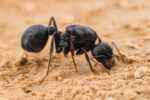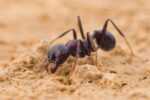Hot




Hurry and get discounts up to 40% Read more
Messor arenarius, also known as the Harvester Ant, is a fascinating ant species that is perfect for collectors. It is the second largest species of Messor in the world and has unique behaviors that will captivate any ant enthusiast.
zł 869.90 – zł 999.90
We give a 100% guarantee for the delivery of a live queen and colony to the client. You can read more about guarantees on the Guarantees page.
The most important thing is that you read the temperature conditions, moisture and what to feed the ants. It is important not to introduce too small a colony into a large formicarium, much less just one queen. It’s good if the formicarium is divided by partitions and if the first chamber is very small (such as in our Comfort formicarium). We recommend reading more information about keeping ants in our blogs!
 Difficulty in breeding
Difficulty in breeding | |
|---|---|
 Behavior
Behavior | |
 Wintering
Wintering | |
 The size of ants
The size of ants | |
 Origin
Origin |
If you’re looking for a fascinating ant species to add to your collection, look no further than Messor arenarius. Known as the harvester ant, *Messor arenarius* is the second largest species of *Messor* in the world. With its impressive size and unique behaviors, this ant is sure to captivate any ant enthusiast.
One notable feature of Messor arenarius is its monogyny colony type. This means that each colony consists of a single queen, making it an excellent *choice for* ant keepers looking for a manageable number of ants. The colony size can reach up to 5000 workers, providing a busy and active ant farm experience.
The queen of Messor arenarius measures between 18-23mm in length, while the workers range from 4-13mm. The major workers, responsible for specialized tasks within the colony, are slightly larger, measuring 14-19mm. All members of the colony have a striking black coloration, adding to their visual appeal.
Messor arenarius has specific dietary preferences. In the wild, they primarily consume *insects such as cockroaches and crickets*. However, they also have a fondness for seeds. Providing a varied diet of both insects and seeds is essential for the **health and well-being** of your ant colony.
Creating the ideal habitat for Messor arenarius is crucial for their success and development. They thrive in warm, dry environments with plenty of sandy soil. To mimic their natural habitat, it is important to provide a sand-filled setup with areas for foraging, nesting, and social interactions.
*Messor arenarius* ants are active foragers, constantly on the lookout for food sources. They navigate the environment using pheromone trails, ensuring efficient movement between their nests and food locations. To simulate this behavior, you can create a foraging area by placing small dishes with food and water in the ant farm.
Messor arenarius ants exhibit fascinating behaviors and specializations within their colonies. Major workers have enlarged mandibles, allowing them to efficiently cut and transport seeds. These seeds are then stored in granaries within the nest, providing a long-term food supply.
The workers also exhibit division of labor, with some individuals focusing on foraging, while others tend to the queen and larvae. This intricate social structure ensures the **well-being and productivity** of the colony.
If you’re interested in keeping Messor arenarius ants, it is important to provide them with a suitable ant farm setup. This can be achieved by using a formicarium, which is a specially designed enclosure that mimics the natural habitat of these ants.
The formicarium should include a nesting area, where the queen and brood can be safely housed, as well as a foraging area where the workers can search for food. The nesting area should have a moist substrate to maintain proper humidity levels. Providing a heating element can help create the warm temperature conditions ideal for Messor arenarius.
Regular maintenance of the ant farm is essential to ensure the **health and well-being** of your Messor arenarius colony. This includes providing a balanced diet, cleaning the farm regularly, and monitoring the temperature and humidity levels.
Messor arenarius, the harvester ant, is a captivating ant species that offers a unique and rewarding experience for ant enthusiasts. From their impressive size and striking black coloration to their specialized behaviors and dietary preferences, these ants are sure to captivate and fascinate anyone who keeps them.
By providing the ideal habitat and care for your Messor arenarius colony, you can observe the intricate social interactions and marvel at their industrious nature. So if you’re looking to add an intriguing ant species to your collection, Messor arenarius is an excellent choice!
Only logged in customers who have purchased this product may leave a review.
No account yet?
Create an Account
Reviews
There are no reviews yet.